Designing Innovative Assistive Technology Devices for Tourism
Abstract
1. Introduction
- Activities requiring practically no movement or exercise: reading, watching TV, listening to the radio, and other similar activities;
- Moderate physical activity: walking, gymnastics, or other forms of relatively moderate exercise;
- Considerable physical activity: swimming, other recreational sports, seasonal gardening, and other outdoor leisure activity;
- Sports activity: intensive training (e.g., at a gym) or competitive sports.
2. Diagnosis of Needs: Challenges in the Field of Active Tourism for People with Disabilities
2.1. Tourism of People with Disabilities
2.2. Satisfying the Transport Needs of People with Disabilities
2.3. Present-Day Development of Rehabilitation Engineering Tools to Satisfy Needs Related to Active Tourism
- Golf carts (for people with disabilities of lower extremities, making it possible to stand upright and preventing the risk of a fall);
- Wheelchairs adapted to travel on the beach and in the forest, equipped with electric engines and stabilized using electronic gyroscopes with multiaxial suspension, moving on cross-country tires or caterpillar tracks;
- Wheelchairs for mountain tourism, with an adequately reinforced frame and wheels, a low seat, with an electric or hybrid engine—a combination of the strength of human muscles and an electric drive—, with widely spaced wheels, frequently with additional handles facilitating pushing, pulling or carrying by assisting individuals). An example of such a vehicle is a special wheelchair designed for a mountain trekking trip to the Himalayas for “Michał Woroch—Himalayas Challenge_2021” [36];
- Equipment designed to facilitate sliding into the water when diving (e.g., with a walking mechanism rather than a wheel drive—according to patent [35]), special stationary equipment to transport individuals with motor disabilities from the shore or river bank to the water, equipment facilitating transfer from a wheelchair to a boat, kayak, and others;
- Wheelchairs and electric or combustion engine vehicles to travel over boggy terrain (with multiple wheel or caterpillar track systems) [40];
- Adapted powered hang gliders—ultralight trikes and adaptations of planes with hand controls;
- Adapted sports cars for disabled drivers;
3. Case Studies of Innovative Devices
3.1. Selection of Cases for Analysis
3.2. A Self-Propelled Carriage Platform for People with Disabilities
- An uncontrolled overload of the wheelchair structure (attachments mounted at elements of the wheelchair structure at points that are not dedicated to such a solution);
- Damage to lacquer coating or at points of attachment mounting or damage to other elements;
- A lack of appropriate operation of combined elements or a lack of potential to combine them;
- Loss of performance properties of used products (e.g., it is impossible to safely sit down in a manual wheelchair with the mounted handbike attachment, altered seat geometry, deterioration of user comfort);
- Increased risk of injury.
- An electric wheeled transporter for a person with disabilities sitting in an active manual wheelchair (Figure 3d) for independent transport on roads, cycling paths, and in open spaces;
- An electric wheeled transporter with a study or work table for a disabled person sitting in a wheelchair (Figure 3e);
- An electric wheeled transporter adapted to transport a disabled person by an assistant (Figure 3f);
- An electric wheeled transporter with an additional lifting system for the manual wheelchair to increase the reach of the user’s arms in the workspace (Figure 3g);
- An electric wheeled transporter with a comfortable armchair securely supporting the body position, e.g., in the car, used for transport both outdoors and indoors (Figure 3h);
- An electric wheeled transporter with an electrically lifted comfortable armchair with an increased range of manipulation for shopping in supermarkets, residential and public buildings, and in urbanized areas (Figure 3i);
- An electric wheeled transporter, with a standing device to verticalization body position, which is especially needed by people sitting in wheelchairs (Figure 3j);
- An electric caterpillar track transporter with a comfortable seat providing secure support for the body using seatbelts for driving in non-urbanized areas for tourism and recreation (Figure 3k).
3.3. The Cam-Thread Drive for a Wheelchair
3.4. A Marine Yacht for People with Disabilities
- The size of the yacht ensures simultaneous long-distance travel for 10–16 people, including a maximum of 4 people moving on wheelchairs;
- The potential for unassisted sailing by senior citizens and people with disabilities independent of non-disabled people;
- Sailing by people with diverse disabilities (optimally for people with different motor, sensory, and mental disabilities as well as those with aging-related dysfunctions traveling together during the same cruise);
- Minimization of yacht size/length (e.g., to reduce fees paid in marinas);
- People with disabilities may perform sailing operations (sail handling, mooring, cooking meals);
- Large, safe, easily accessible open surfaces, e.g., the upper deck superstructure;
- The yacht is equipped with means supporting accessibility for people with disabilities first of all when walking, standing, sitting down, grasping, holding, orientation and identification of space, and receiving information.
4. A Proposal for an Algorithm for the Design of Innovative AT Devices
5. Conclusions
Author Contributions
Funding
Institutional Review Board Statement
Informed Consent Statement
Data Availability Statement
Conflicts of Interest
References
- World Health Organization; World Bank. World Report on Disability 2011; World Health Organization: Valletta, Malta, 2011; ISBN 78-92-4-068521-5. [Google Scholar]
- Lebrasseur, A.; Fortin-Bédard, N.; Lettre, J.; Bussières, E.-L.; Best, K.; Boucher, N.; Hotton, M.; Beaulieu-Bonneau, S.; Mercier, C.; Lamontagne, M.-E.; et al. Impact of COVID-19 on People with Physical Disabilities: A Rapid Review. Disabil. Health J. 2021, 14, 101014. [Google Scholar] [CrossRef] [PubMed]
- World Report on Ageing and Health; World Health Organization: Geneva, Switzerland, 2015; ISBN 92-4-156504-7.
- Milanowska, K.; Dega, W. Rehabilitacja Medyczna/Physical Medicine & Rehabilitation, 4th ed.; Wydawnictwo Lekarskie PZWL: Warszawa, Poland, 2001; ISBN 978-83-200-2607-8. [Google Scholar]
- Lubecki, M. Polski Model Rehabilitacji Medycznej Zaakceptowany i Zalecany Przez WHO/The Polish Model of Rehabilitation Accepted and Recommended by WHO. Hygeia Public Health 2011, 46, 506–515. [Google Scholar]
- Rusk, H.A. Rehabilitation: An International Problem. Arch. Phys. Med. Rehabil. 1956, 37, 135–137. [Google Scholar] [PubMed]
- Kiwerski, J.E. Scientific Idea of Professor Marian Weiss. Ortop. Traumatol. Rehabil. 2021, 23, 213–219. [Google Scholar] [CrossRef]
- Hogan, A.J. Social and Medical Models of Disability and Mental Health: Evolution and Renewal. CMAJ 2019, 191, E16–E18. [Google Scholar] [CrossRef] [PubMed]
- Okoro, C.A.; Hollis, N.D.; Cyrus, A.C.; Griffin-Blake, S. Prevalence of Disabilities and Health Care Access by Disability Status and Type Among Adults—United States, 2016. MMWR Morb. Mortal. Wkly. Rep. 2018, 67, 882–887. [Google Scholar] [CrossRef] [PubMed]
- Courtney-Long, E.A.; Carroll, D.D.; Zhang, Q.C.; Stevens, A.C.; Griffin-Blake, S.; Armour, B.S.; Campbell, V.A. Prevalence of Disability and Disability Type Among Adults—United States, 2013. MMWR Morb. Mortal. Wkly. Rep. 2015, 64, 777–782. [Google Scholar] [CrossRef]
- Centers for Disease Control and Prevention (CDC) CDC Grand Rounds: Public Health Practices to Include Persons with Disabilities. MMWR Morb. Mortal. Wkly. Rep. 2013, 62, 697–701.
- Vos, T.; Lim, S.S.; Abbafati, C.; Abbas, K.M.; Abbasi, M.; Abbasifard, M.; Abbasi-Kangevari, M.; Abbastabar, H.; Abd-Allah, F.; Abdelalim, A.; et al. Global Burden of 369 Diseases and Injuries in 204 Countries and Territories, 1990–2019: A Systematic Analysis for the Global Burden of Disease Study 2019. Lancet 2020, 396, 1204–1222. [Google Scholar] [CrossRef]
- Alkassabi, O.; Voogt, L.; Andrews, P.; Alhowimel, A.; Nijs, J.; Alsobayel, H. Risk Factors to Persistent Pain Following Musculoskeletal Injuries: A Systematic Literature Review. Int. J. Environ. Res. Public Health 2022, 19, 9318. [Google Scholar] [CrossRef]
- Kilian, M.; Śmiechowska-Petrovskij, E. Niepełnosprawność w Okresie Późnej Dorosłości/Disability in Late Adulthood; Oficyna Wydawnicza Impuls: Kraków, Poland, 2018; ISBN 978-83-8095-557-8. [Google Scholar]
- Sydor, M.; Zabłocki, M. Wybrane problemy doboru i konfiguracji wózka inwalidzkiego z napędem ręcznym/Chosen problems of manual wheelchair selection and configuration. Fizjoterapia Pol. 2006, 2, 172–177. [Google Scholar]
- Zabłocki, M.; Branowski, B.K.; Kurczewski, P.; Torzyński, D.; Bonenberg, A.; Gabryelski, J.; Głowala, S.; Pohl, P.; Rychlik, M.T.; Sydor, M.; et al. Wprowadzenie do Inżynierii Rehabilitacyjnej/An Introduction to Rehabilitation Engineering; Zabłocki, M., Ed.; Wydział Maszyn Roboczych i Transportu Politechniki Poznańskiej: Poznań, Poland, 2017; ISBN 978-83-941828-1-6. [Google Scholar]
- Pyaneandee, C. International Disability Law: A Practical Approach to the United Nations Convention on the Rights of Persons with Disabilities; Routledge: New York, NY, USA, 2018; ISBN 978-1-138-59346-6. [Google Scholar]
- Rasmussen, M.; Lewis, O. United Nations Convention on the Rights of Persons With Disabilities. Int. Leg. Mater. 2007, 46, 441–466. [Google Scholar] [CrossRef]
- Nowacki, M.; Błacha, R. Żeglarstwo w Rekreacji/Sailing for Recreation. In Sport dla Wszystkich. Wybrane Dyscypliny/Sports for Everyone. Selected Disciplines; Wolańska, T., Lisowska, J., Eds.; Biblioteka Polskiego Towarzystwa Naukowego Kultury Fizycznej; Estrella: Warszawa, Poland, 1997; Volume 8, pp. 81–85. ISBN 83-86622-32-6. [Google Scholar]
- Jaskólski, A.; Jaskólska, A. Podstawy Fizjologii Wysiłku Fizycznego z Zarysem Fizjologii Człowieka/Fundamentals of Physical Exercise Physiology with an Outline of Human Physiology, 3rd ed.; Wydawnictwo Akademii Wychowania Fizycznego: Wrocław, Poland, 2006; ISBN 83-89156-41-5. [Google Scholar]
- Sivan, M.; Phillips, M.; Baguley, I.; Nott, M. (Eds.) Oxford Handbook of Rehabilitation Medicine, 3rd ed.; Oxford University Press: Oxford, UK, 2019; ISBN 978-0-19-182738-9. [Google Scholar]
- Plewa, M.; Markiewicz, A. Aktywność Fizyczna w Profilaktyce i Leczeniu Otyłości/Physical Activity in the Prevention and Treatment of Obesity. Endokrynol. Otyłość I Zaburzenia Przemiany Mater. 2006, 2, 30–37. [Google Scholar]
- Divanoglou, A.; Tasiemski, T.; Augutis, M.; Trok, K. Active Rehabilitation—A Community Peer-Based Approach for Persons with Spinal Cord Injury: International Utilisation of Key Elements. Spinal Cord 2017, 55, 545–552. [Google Scholar] [CrossRef]
- Ciecieląg, P.; Lednicki, B.; Moskalewicz, J.; Piekarzewska, M.; Sierosławski, J.; Waligórska, M.; Zajenkowska-Kozłowska, A. Stan Zdrowia Ludności Polski w 2004 r./Health Status of the Polish Population in 2004; Marciniak, G., Ed.; Informacje i Opracowania Statystyczne/Information and Statistical Studies; Główny Urząd Statystyczny: Warszawa, Poland, 2006. [Google Scholar]
- Śledzińska, J. Turystyka Osób Niepełnosprawnych w Polskim Towarzystwie Turystyczno- Krajoznawczym/Tourism for the Disabled in the Polish Tourism and Sightseeing Society. Niepełnosprawność 2012, 3, 81–103. [Google Scholar]
- Analiza Rozwoju Turystyki Społecznej w Polsce. Stan, Szanse i Zagrożenia/Analysis of the Development of Social Tourism in Poland. Status, Opportunities and Threats; Instytut Turystyki: Warszawa, Poland, 2007; p. 60. [Google Scholar]
- Bauer, I. When Travel Is a Challenge: Travel Medicine and the ‘Dis-Abled’ Traveller. Travel Med. Infect. Dis. 2018, 22, 66–72. [Google Scholar] [CrossRef]
- Kaganek, K. Bariery Uprawiania Turystyki Przez Osoby Niepełnosprawne w Kontekście Statusu Materialnego/Barriers in Practicing Tourism by the Disabled from the Aspect of Material Status. Med. Ogólna Nauk. Zdrowiu 2015, 21, 77–83. [Google Scholar] [CrossRef]
- Cooper, R.A. Rehabilitation Engineering Applied to Mobility and Manipulation/Rory A. Cooper; Medical science series; Institute of Physics Pub: Bristol, UK; Philadelphia, PA, USA, 1995; ISBN 978-0-7503-0343-9. [Google Scholar]
- Alén, E.; Losada, N.; Domínguez, T. The Impact of Ageing on the Tourism Industry: An Approach to the Senior Tourist Profile. Soc. Indic. Res. 2016, 127, 303–322. [Google Scholar] [CrossRef]
- Bekiaris, E.; Loukea, M.; Panou, M.; Földesi, E.; Jammes, T. Seamless Accessibility of Transportation Modes and Multimodal Transport Across Europe: Gaps, Measures and Best Practices. In Towards User-Centric Transport in Europe 2: Enablers of Inclusive, Seamless and Sustainable Mobility; Müller, B., Meyer, G., Eds.; Springer International Publishing: Cham, Switzerland, 2020; pp. 43–59. ISBN 978-3-030-38028-1. [Google Scholar]
- Handbook on Ageing with Disability, 1st ed.; Putnam, M., Bigby, C., Eds.; Routledge: New York, NY, USA, 2021; ISBN 978-1-138-61149-8. [Google Scholar]
- Shrestha, B.P.; Millonig, A.; Hounsell, N.B.; McDonald, M. Review of Public Transport Needs of Older People in European Context. Popul. Ageing 2017, 10, 343–361. [Google Scholar] [CrossRef]
- King, T.W. Assistive Technology: Essential Human Factors; Allyn & Bacon: Boston, FL, USA, 1999; ISBN 978-0-205-27326-3. [Google Scholar]
- Bochnacki, A.; Gwiazdowski, A. Mechanizm Kroczący/Walking Mechanism. Patent Application PL 347277 A1, 4 November 2002. [Google Scholar]
- Woroch, M. Granica Śniegu, Granica Możliwości/The Snow Line, the Limit of Possibilities. Wystąpienia i Prezentacje Podróżnicze/Travel Presentations. 2019. Available online: https://michalworoch.com/wystapienia/ (accessed on 15 August 2022).
- Hettinga, F.J.; Valent, L.; Groen, W.; van Drongelen, S.; de Groot, S.; van der Woude, L.H.V. Hand-Cycling: An Active Form of Wheeled Mobility, Recreation, and Sports. Phys. Med. Rehabil. Clin. N. Am. 2010, 21, 127–140. [Google Scholar] [CrossRef]
- Branowski, B.; Kurczewski, P.; Torzyński, D.; Zablocki, M. Napęd Ręczny dla Pojazdów, w Szczególności Wózków Inwalidzkich Ręcznych/Manual Drive for Vehicles, in Particular for Manual Wheelchairs. Patent Application PL 427338 A1, 2020. [Google Scholar]
- Kukla, M.; Wieczorek, B.; Warguła, Ł.; Górecki, J.; Giedrowicz, M. An Analytical Modelling of Demand for Driving Torque of a Wheelchair with Electromechanical Drive. Energies 2021, 14, 7315. [Google Scholar] [CrossRef]
- Chacon-Cifuentes, P.; Zuleta, A.A.; Sevilla, G.; Valencia-Escobar, A.; Correa-Bedoya, E.; Echeverria-Echeverria, F. Human Factors in All-Terrain Wheelchair Design for Rural Population. In Advances in Usability and User Experience; Ahram, T., Falcão, C., Eds.; Advances in Intelligent Systems and Computing; Springer International Publishing: Cham, Switzerland, 2020; Volume 972, pp. 899–910. ISBN 978-3-030-19134-4. [Google Scholar]
- Collotta, M.; Freddi, P.; Freddi, P.; Frialdi, F.; Solazzi, L. Design and Realization of a Swivelling Seat for a Paralympic Racing Boat. J. Access. Des. All 2017, 7, 198–217. [Google Scholar] [CrossRef]
- Kurczewski, P.; Torzyński, D.; Zabłocki, M. Stanowisko Sterowe dla Osób z Niepełnosprawnościami na Wózkach Inwalidzkich/A Steering Stand for People with Disabilities in Wheelchairs. Patent Aplication PL 43317620 A, 13 September 2021. [Google Scholar]
- Garton, M.B. Levelling the Disability Hierarchy. Eureka Str. 2010, 20, 3–4. [Google Scholar]
- Woroch, M. Krok po kroku: Z Ziemi Ognistej na Alaskę/Step by step: From Tierra del Fuego to Alaska; Michał Woroch: Janowiec Wielkopolski, Poland, 2019; ISBN 978-83-953277-0-4. [Google Scholar]
- Branowski, B.; Zabłocki, M.; Kurczewski, P.; Walczak, A. Selected Issues in Universal Design of Yachts for People with Disabilities. Pol. Marit. Res. 2021, 28, 4–15. [Google Scholar] [CrossRef]
- Rachele, J.N.; Wiesel, I.; van Holstein, E.; Feretopoulos, V.; de Vries, T.; Green, C.; Bicknell, E. Feasibility and the Care-Full Just City: Overlaps and Contrasts in the Views of People with Disability and Local Government Officers on Social Inclusion. Cities 2020, 100, 102650. [Google Scholar] [CrossRef]
- Kim, J.J.; Lee, J.; Shin, J.; He, M. How Are High-Tech Assistive Devices Valued in an Aging Society? Exploring the Use and Non-Use Values of Equipment That Aid Limb Disability. Technol. Soc. 2022, 70, 102013. [Google Scholar] [CrossRef]
- Europe 2020. A Strategy for Smart, Sustainable and Inclusive Growth. 2010.03.03 by European Commission. Available online: https://ec.europa.eu/eu2020/pdf/COMPLET%20EN%20BARROSO%20%20%20007%20-%20Europe%202020%20-%20EN%20version.pdf (accessed on 15 August 2022).
- Branowski, B.; Zabłocki, M. Rozwój Konstrukcji Pojazdów Dla Osób z Niepełnosprawnościami Motorycznymi/Development of Vehicles for People with Motor Disabilities. In Wybrane Kierunki Badań Ergonomicznych w 2017 Roku; Charytonowicz, J., Ed.; Zastosowania Ergonomii; Wydawnictwo Polskiego Towarzystwa Ergonomicznego PTErg Odział we Wrocławiu: Wrocław, Poland, 2017; pp. 83–98. ISBN 978-83-63626-07-5. [Google Scholar]
- Wieczorek, B.; Branowski, B.K.; Głowala, S.; Zabłocki, M. Pojazd Transportowy lub Rehabilitacyjny dla Osób z Niepełnosprawnością Ruchu/Transport or Rehabilitation Vehicle for Persons with Motor Disability. Granted Patent PL 228166 B1, 23 November 2015. [Google Scholar]
- Pahl/Beitz Konstruktionslehre: Methoden und Anwendung erfolgreicher Produktentwicklung; Pahl/Beitz Konstruktionslehre; 8., vollst. überarb. Aufl. 2013; Springer: Berlin, Germany, 2012; ISBN 978-3-642-29569-0.
- Wieczorek, B.; Kukla, M. Biomechanical Relationships Between Manual Wheelchair Steering and the Position of the Human Body’s Center of Gravity. J. Biomech. Eng. 2020, 142, 081006. [Google Scholar] [CrossRef]
- Kukla, M.; Wieczorek, B.; Warguła, Ł.; Berdychowski, M. An Analytical Model of the Demand for Propulsion Torque during Manual Wheelchair Propelling. Disabil. Rehabil. Assist. Technol. 2021, 16, 9–16. [Google Scholar] [CrossRef]
- Gabryelski, J.; Kurczewski, P.; Sydor, M.; Szperling, A.; Torzyński, D.; Zabłocki, M. Development of Transport for Disabled People on the Example of Wheelchair Propulsion with Cam-Thread Drive. Energies 2021, 14, 8137. [Google Scholar] [CrossRef]
- Simhony, I. The Uri, a Blue-Water Motorsailer Architected by Itay Simhony of Raffles Yacht Shipyard. Italy. 1992. Available online: https://www.wheelchairsailing.com/ (accessed on 31 August 2022).
- Baily, N. The Impossible Dream, a Catamaran Designed by Nick Baily and Built by Multi-Marine, USA. 2002. Available online: www.theimpossibledream.org (accessed on 31 August 2022).
- Hao, C.; Zihai, Z. Novel Yacht Steering Wheel Based on Multiple Protection Structure. A Limited Patent CN 206068111 U, 5 April 2017. [Google Scholar]
- Guomin, Z.; Jinglei, S.; Chaohua, W. Minitype Yacht Steering Wheel. A Limited Patent CN 203902833 U, 29 October 2014. [Google Scholar]
- Santos, A.V.F.; Silveira, Z.C. Design for Assistive Technology Oriented to Design Methodology: A Systematic Review on User-Centered Design and 3D Printing Approaches. J. Braz. Soc. Mech. Sci. Eng. 2021, 43, 483. [Google Scholar] [CrossRef]
- Federici, S.; Meloni, F.; Corradi, F. Measuring Individual Functioning. In Assistive Technology Assessment Handbook; Federici, S., Marcia, J., Scherer, Eds.; Rehabilitation Science in Practice; CRC Press, Taylor & Francis Group: Boca Raton, FL, USA, 2017; pp. 27–51. ISBN 978-1-4987-7412-3. [Google Scholar]
- Branowski, B.; Zabłocki, M. Kreacja i Kontaminacja Zasad Projektowania i Zasad Konstrukcji w Projektowaniu dla Osób Niepełnosprawnych/Creation and Contamination of Design Principles and Construction Principles in Designing for People with Disabilities. In Ergonomia Produktu. Ergonomiczne Zasady Projektowania Produktów/Product Ergonomics. Ergonomic Principles of Product Design; Jabłoński, M., Ed.; Wydawnictwo Politechniki Poznańskiej: Poznań, Poland, 2006; pp. 73–106. ISBN 83-7143-238-0. [Google Scholar]
- ISO 9241-210:2019; Ergonomics of Human-System Interaction—Part 210: Human-Centred Design for Interactive Systems. ISO: Geneva, Switzerland, 2019.
- Karwowski, W. (Ed.) Handbook of Standards and Guidelines in Ergonomics and Human Factors, 1st ed.; CRC Press: Boca Raton, FL, USA, 2005; ISBN 978-0-429-18989-0. [Google Scholar]
- Salvendy, G. (Ed.) Handbook of Human Factors and Ergonomics, 4th ed.; Wiley: Hoboken, NJ, USA, 2012; ISBN 978-0-470-52838-9. [Google Scholar]
- Branowski, B.; Pohl, P.; Rychlik, M.; Zablocki, M. Integral Model of the Area of Reaches and Forces of a Disabled Person with Dysfunction of Lower Limbs as a Tool in Virtual Assessment of Manipulation Possibilities in Selected Work Environments. In Universal Access in Human-Computer Interaction: Users Diversity, Pt 2; Stephanidis, C., Ed.; Springer: Berlin, Germany, 2011; Volume 6766, pp. 12–21. ISBN 978-3-642-21662-6. [Google Scholar]
- Branowski, B.; Pacholski, L.; Rychlik, M.; Zabłocki, M.; Pohl, P. Studies on a New Concept of 3D Data Integration about Reaches and Forces of a Disabled Person on a Wheelchair (CAD Methods in Car and Market Ergonomics). Hum. Factors Man. 2013, 23, 255–266. [Google Scholar] [CrossRef]
- Bonenberg, A.; Branowski, B.; Kurczewski, P.; Lewandowska, A.; Sydor, M.; Torzyński, D.; Zabłocki, M. Designing for Human Use: Examples of Kitchen Interiors for Persons with Disability and Elderly People. Hum. Factors Man. 2019, 29, 177–186. [Google Scholar] [CrossRef]
- Branowski, B.; Zabłocki, M.; Kurczewski, P.; Sydor, M. A Method for Modeling the Individual Convenient Zone of a Human. Int. J. Environ. Res. Public Health 2022, 19, 10405. [Google Scholar] [CrossRef]
- Sydor, M.; Krauss, A.; Krauss, H. Risk Analysis for Operation of Active Wheelchairs in Non-Urban Settings. Ann. Agric. Environ. Med. 2017, 24, 532–536. [Google Scholar] [CrossRef]
- Branowski, B.; Zabłocki, M.; Gabryelski, J.; Walczak, A.; Kurczewski, P. Hazard Analysis of a Yacht Designed for People with Disabilities. ISP 2022, 68, 105–128. [Google Scholar] [CrossRef]
- PN-EN ISO 14971:2012; Medical Devices—Application of Risk Management to Medical Devices. The Polish Committee for Standardization: Warsaw, Poland, 2012.
- Rohatyński, R. Przegląd Modeli Procesu Projektowania/A Review of Design Process Models. In Proceedings of the XXI Sympozjon Podstaw Konstrukcji Maszyn/XXI Symposium on Fundamentals of Machine Design; Wydawnictwo Naukowe Akademii Techniczno-Humanistycznej w Bielsku-Białej: Bielsko-Biała, Poland, 2003; Volume 1, pp. 23–44. [Google Scholar]
- Vajna, S.; Bercsey, T.; Clement, S.; Jordan, A.; Mack, P. Autogenetische Konstruktionstheorie–Ein Beitrag Für Eine Erweiterte Konstruktionstheorie. Konstruktion 2004, 3, 71–77. [Google Scholar]
- Lindemann, U. Methodische Entwicklung technischer Produkte: Methoden flexibel und situationsgerecht anwenden; VDI-Buch; 3., korrigierte Aufl.; Springer: Dordrecht, The Netherlands; Germany/Heidelberg, Germany, 2009; ISBN 978-3-642-01423-9. [Google Scholar]
- Cooper, R.A.; Ohnabe, H.; Hobson, D.A. An Introduction to Rehabilitation Engineering; Taylor & Francis: Boca Raton, FL, USA, 2007; ISBN 978-1-4200-1249-1. [Google Scholar]
- Zabłocki, M. Aspekty Ergonomiczne w Badaniu Potrzeb i Formułowaniu Wymagań Projektowych/Ergonomic Aspects in Researching Needs and Formulating Design Requirements. In Zastosowania Ergonomii: Wybrane Kierunki Badań Ergonomicznych w 2013 Roku/Applications of Ergonomics: Selected Directions of Ergonomic Research in 2013; Charytonowicz, J., Ed.; Wydawnictwo Polskiego Towarzystwa Ergonomicznego PTErg. Oddział we Wrocławiu: Wrocław, Poland, 2013; pp. 51–62. ISBN 978-8-392-66309-6. [Google Scholar]
- Zabłocki, M. Aspekty Systemowe i Procesowe w Projektowaniu Technicznym dla Osób z Niepełnosprawnościami/System and Process Aspects in Technical Design for People with Disabilities; Rozprawy—Politechnika Poznańska; Wydawnictwo Politechniki Poznańskiej: Poznań, Poland, 2013; Volume 495, ISBN 978-83-7775-257-9. [Google Scholar]

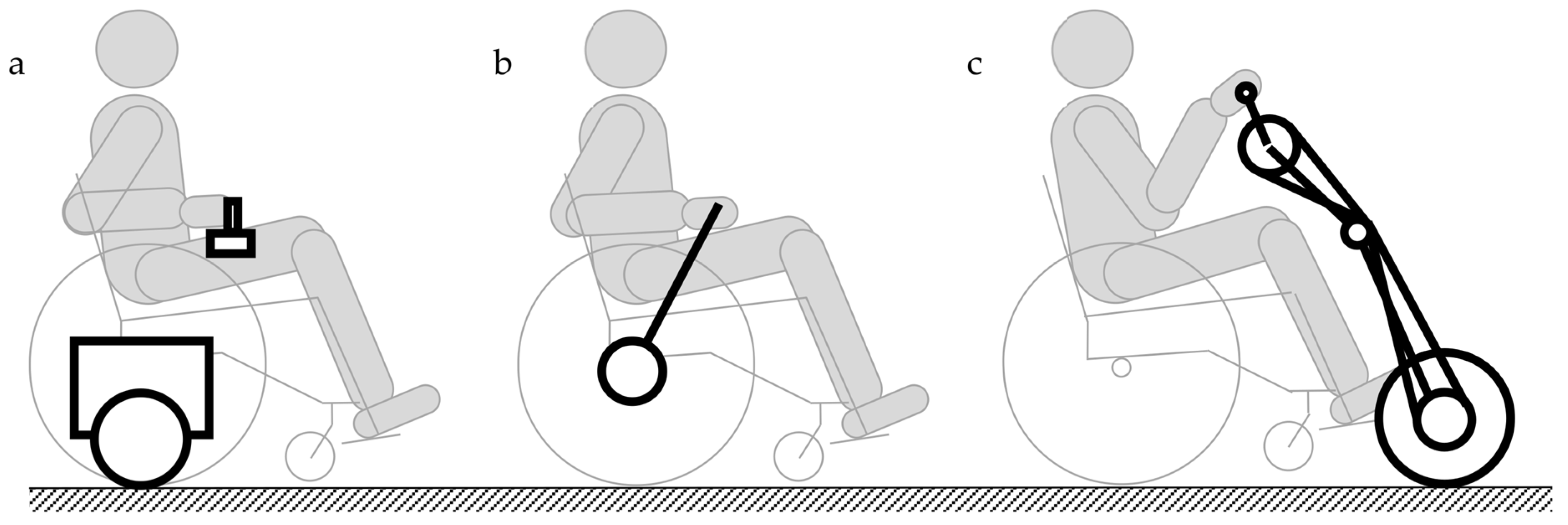

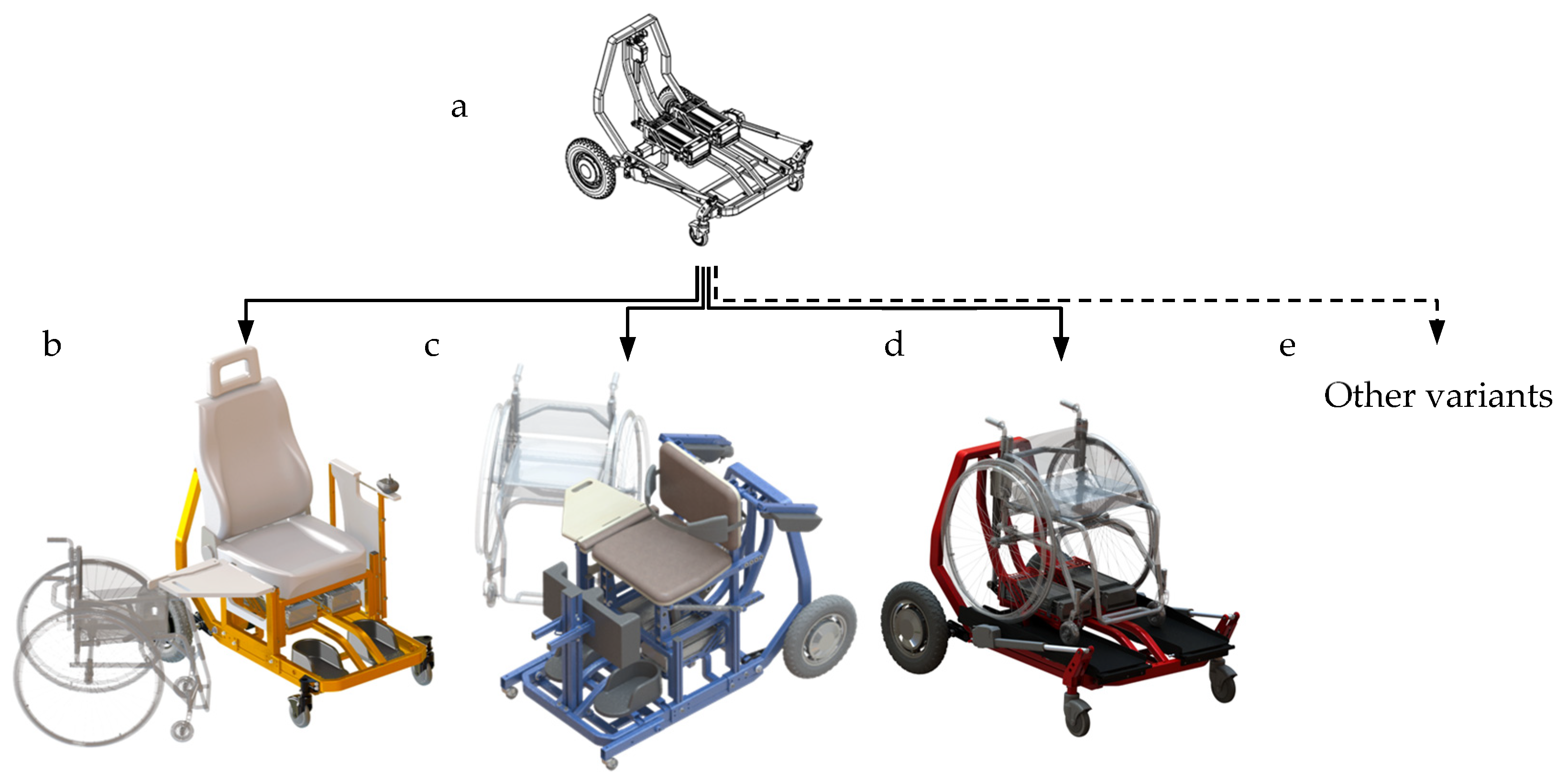
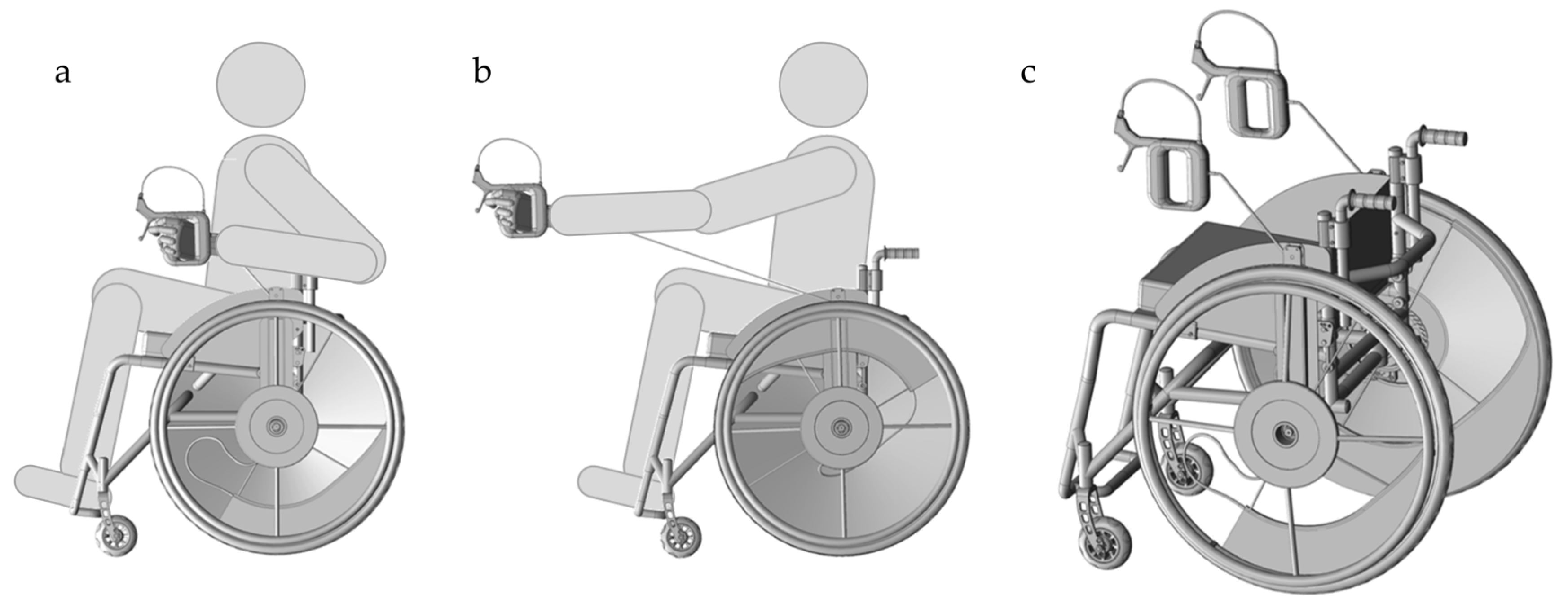
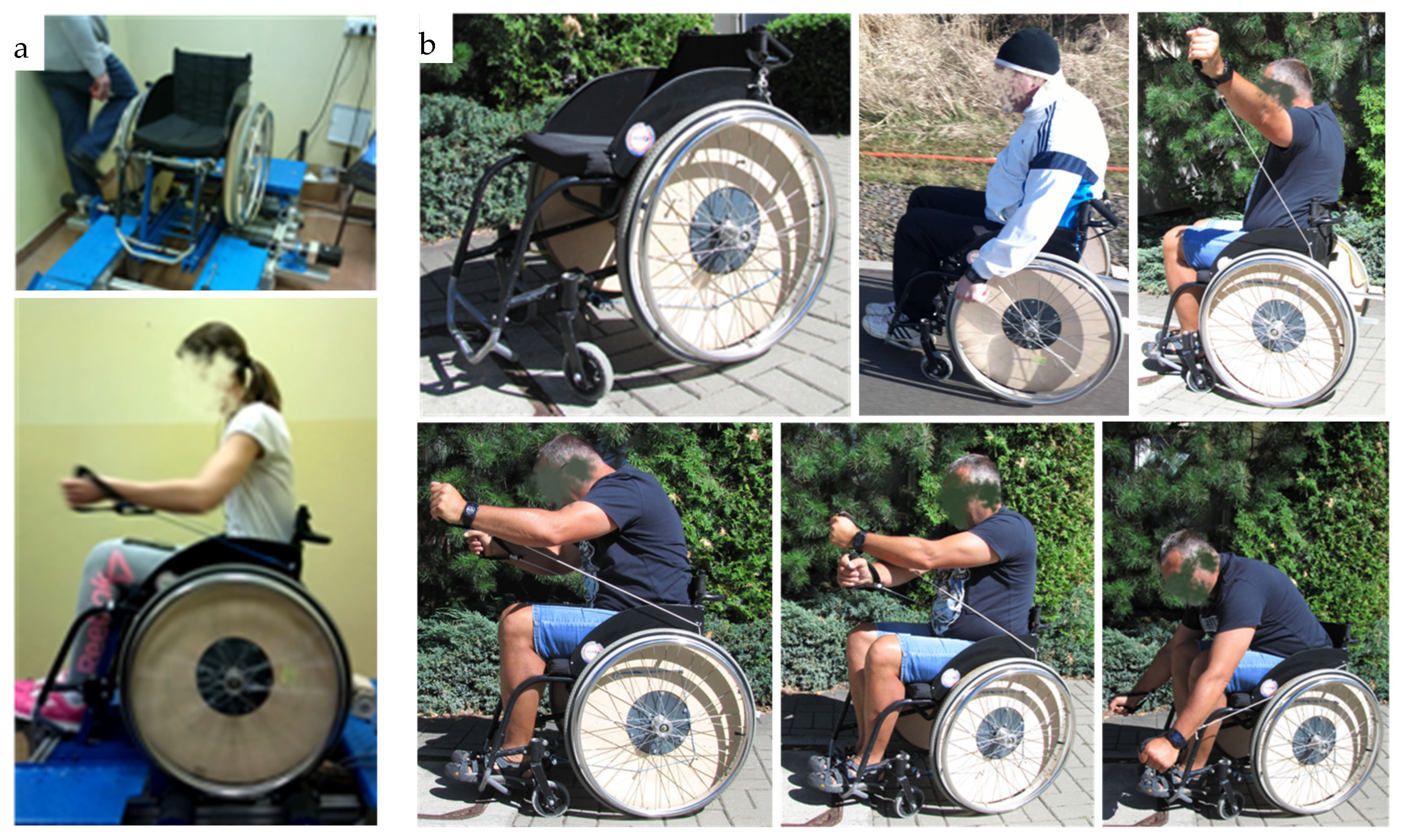

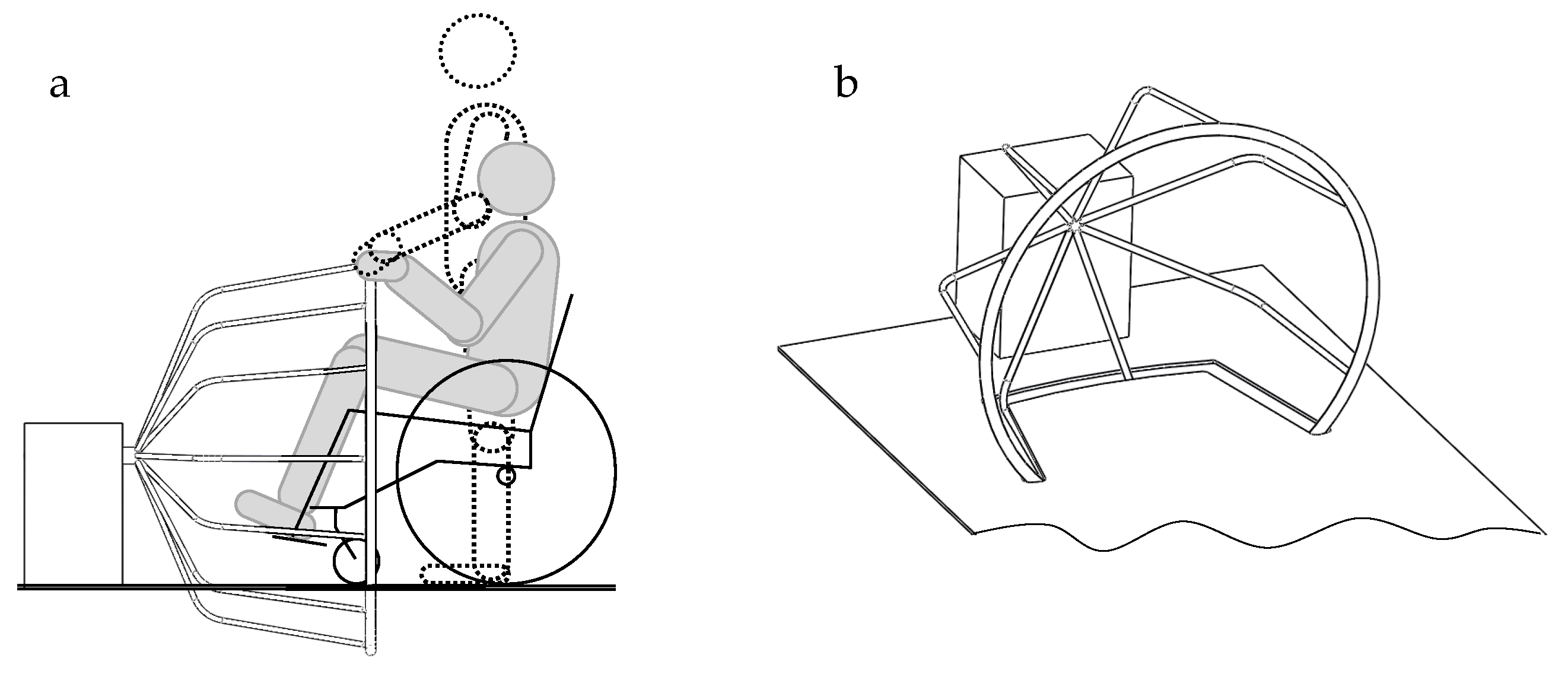

Publisher’s Note: MDPI stays neutral with regard to jurisdictional claims in published maps and institutional affiliations. |
© 2022 by the authors. Licensee MDPI, Basel, Switzerland. This article is an open access article distributed under the terms and conditions of the Creative Commons Attribution (CC BY) license (https://creativecommons.org/licenses/by/4.0/).
Share and Cite
Zabłocki, M.; Branowski, B.; Kurczewski, P.; Gabryelski, J.; Sydor, M. Designing Innovative Assistive Technology Devices for Tourism. Int. J. Environ. Res. Public Health 2022, 19, 14186. https://doi.org/10.3390/ijerph192114186
Zabłocki M, Branowski B, Kurczewski P, Gabryelski J, Sydor M. Designing Innovative Assistive Technology Devices for Tourism. International Journal of Environmental Research and Public Health. 2022; 19(21):14186. https://doi.org/10.3390/ijerph192114186
Chicago/Turabian StyleZabłocki, Marek, Bogdan Branowski, Przemysław Kurczewski, Jarosław Gabryelski, and Maciej Sydor. 2022. "Designing Innovative Assistive Technology Devices for Tourism" International Journal of Environmental Research and Public Health 19, no. 21: 14186. https://doi.org/10.3390/ijerph192114186
APA StyleZabłocki, M., Branowski, B., Kurczewski, P., Gabryelski, J., & Sydor, M. (2022). Designing Innovative Assistive Technology Devices for Tourism. International Journal of Environmental Research and Public Health, 19(21), 14186. https://doi.org/10.3390/ijerph192114186





